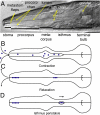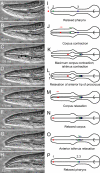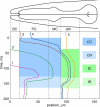Two size-selective mechanisms specifically trap bacteria-sized food particles in Caenorhabditis elegans
- PMID: 19903886
- PMCID: PMC2785297
- DOI: 10.1073/pnas.0904036106
Two size-selective mechanisms specifically trap bacteria-sized food particles in Caenorhabditis elegans
Abstract
Caenorhabditis elegans is a filter feeder: it draws bacteria suspended in liquid into its pharynx, traps the bacteria, and ejects the liquid. How pharyngeal pumping simultaneously transports and filters food particles has been poorly understood. Here, we use high-speed video microscopy to define the detailed workings of pharyngeal mechanics. The buccal cavity and metastomal flaps regulate the flow of dense bacterial suspensions and exclude excessively large particles from entering the pharynx. A complex sequence of contractions and relaxations transports food particles in two successive trap stages before passage into the terminal bulb and intestine. Filtering occurs at each trap as bacteria are concentrated in the central lumen while fluids are expelled radially through three apical channels. Experiments with microspheres show that the C. elegans pharynx, in combination with the buccal cavity, is tuned to specifically catch and transport particles of a size range corresponding to most soil bacteria.
Conflict of interest statement
The authors declare no conflict of interest.
Figures




References
-
- Albertson DG, Thomson JN. The pharynx of Caenorhabditis elegans. Philos Trans R Soc Lond B Biol Sci. 1976;275:299–325. - PubMed
-
- Purcell EM. Life at low Reynolds number. Am J Phys. 1977;45:3–11.
-
- Seymour MK, Wright KA, Doncaster CC. The action of the anterior feeding apparatus of Caenorhabditis elegans (Nematoda, Rhabditida) J Zool. 1983;201:527–539.
Publication types
MeSH terms
Grants and funding
LinkOut - more resources
Full Text Sources
Other Literature Sources

